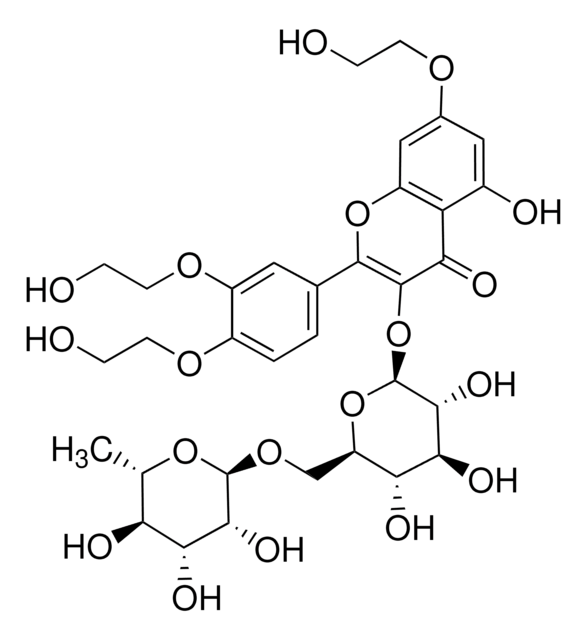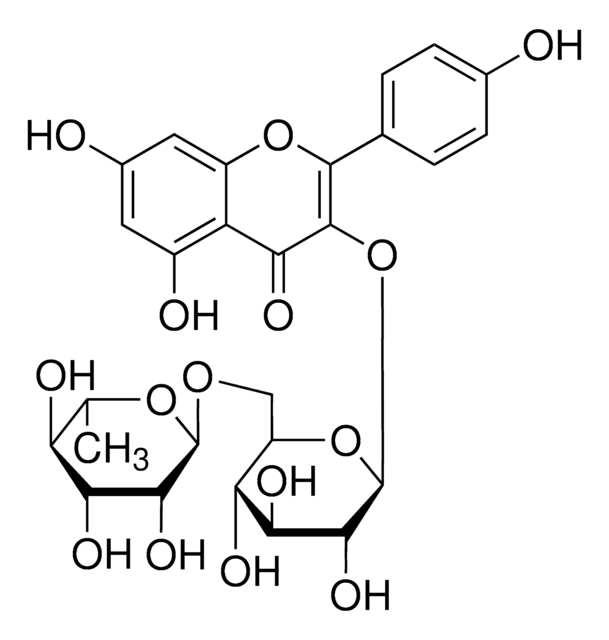PHL89270
Rutin
phyproof® Reference Substance
Synonyme(s) :
3,3′,4′,5,7-Pentahydroxyflavone 3-rutinoside, 3-Rutinosylquercetin, Globulariacitrin, Ilixanthi, Myrticalorin, Osyritrin, Paliuroside, Phytomelin, Quercetin 3-rhamnoglucoside, Quercetin 3-rutinoside, Rutoside, Sophorin, Tanrutin, Violaquercitrin
About This Item
Produits recommandés
Qualité
primary reference standard
Gamme de produits
phyproof® Reference Substance
Pureté
≥95.0% (HPLC)
Fabricant/nom de marque
PhytoLab
Application(s)
food and beverages
Format
neat
InChI
1S/C27H30O16/c1-8-17(32)20(35)22(37)26(40-8)39-7-15-18(33)21(36)23(38)27(42-15)43-25-19(34)16-13(31)5-10(28)6-14(16)41-24(25)9-2-3-11(29)12(30)4-9/h2-6,8,15,17-18,20-23,26-33,35-38H,7H2,1H3/t8-,15+,17-,18+,20+,21-,22+,23+,26+,27-/m0/s1
Clé InChI
IKGXIBQEEMLURG-NVPNHPEKSA-N
Catégories apparentées
Description générale
Rutin, also known as vitamin P, is an abundantly found polyphenolic flavonoid, known for its anti-inflammatory, antitumor, and anticancer properties.
Application
- Electrochemical determination of rutin using a glassy carbon electrode (GCE), modified by a copper-complexed chitosan/multiwalled carbon nanotubes (Cu-CS/MWCNT) in fruit samples of orange, lemon, lime, and apple
- Cyclic voltametric detection and quantification of rutin in pharmaceutical formulations using novel nickel nanoparticles-graphene oxide composite-glassy carbon electrode (Ni-GO/GCE)
- Spectrofluorimetric quantification of rutin in a pharmaceutical sample using carbon dots (CDs) prepared from a non-essential amino acid precursor, L-asparagine
- Analysis of human serum and pharmaceutical tablet samples for the estimation of rutin by using a porous carbon-cobalt tungstate (PC/CoWO4) nanosheet based electrochemical sensor
- Simultaneous determination of rutin and isoquercitrin by differential pulse voltammetry (DPV) using glassy carbon electrode (GCE) modified with deposition of thio-β-cyclodextrin functionalized graphene/palladium nanoparticles (SH-β-CD-Gr/PdNPs) for pharmaceutical and medical analysis
- Ionic liquid vacuum microwave-assisted extraction (ILVMAE) of rutin, hyperoside, and hesperidin from Sorbus tianschanica leaf samples for their subsequent quantification by HPLC
- Simultaneous detection and quantification of vitexin, rutin, hyperoside, and quercetin in hawthorn flower and leaf extract samples using high-performance liquid chromatography combined with spectrophotometric detection (HPLC-UV)
Autres remarques
Informations légales
Code de la classe de stockage
11 - Combustible Solids
Classe de danger pour l'eau (WGK)
WGK 1
Point d'éclair (°F)
Not applicable
Point d'éclair (°C)
Not applicable
Faites votre choix parmi les versions les plus récentes :
Certificats d'analyse (COA)
Vous ne trouvez pas la bonne version ?
Si vous avez besoin d'une version particulière, vous pouvez rechercher un certificat spécifique par le numéro de lot.
Déjà en possession de ce produit ?
Retrouvez la documentation relative aux produits que vous avez récemment achetés dans la Bibliothèque de documents.
Les clients ont également consulté
Notre équipe de scientifiques dispose d'une expérience dans tous les secteurs de la recherche, notamment en sciences de la vie, science des matériaux, synthèse chimique, chromatographie, analyse et dans de nombreux autres domaines..
Contacter notre Service technique








